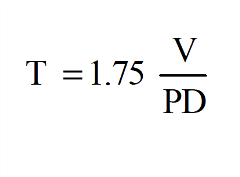The time required to reduce the vapor pressure to about 25% of its original level may be estimated by:
T is Time (Minutes)
V is the Vessel’s Volume (M
3)
PD is the Compressor’s Piston Displacement (M
3/min)
(V may be expressed in ft
3 if PD is in ft
3/min)
